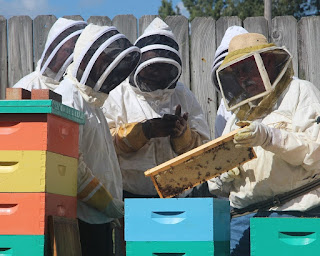I was honored to be invited to speak about bees and
beekeeping to the entomology class at the University of Central Arkansas. We
discussed the development of modern beekeeping from its early roots as a
tradition of honey hunting. We looked at the evolution of bee hives from clay
hives and woven skeps to hollow log “bee gums.” We observed the traditional tree-mounted
cylindrical hives of Africa, the transitional Kenyan top bar hives, and finally
the modern Langstroth hives. We also viewed the horizontal hives of eastern
Europe and the vertical top bar hive, the Warre hive.
Following the classroom session, the students travelled to
explore my nearby pollinator garden and bee hives. Pollinator gardens are any planting
that provides flowering plants producing nectar and pollen. These gardens also include
water, protective vegetative cover, and insect nesting spaces. Anyone planning
a pollinator garden should restrict the use of pesticides. Flowering plants are
chosen that bloom throughout the spring, summer, and fall. Bare ground provides
nesting places for solitary bees, which largely nest underground. The
entomology students collected insects from the pollinator garden, water garden,
composters, and vitex trees. They observed orb spiders also gathering flying
insects that ventured into their expansive webs. Students dug ant lion larvae
from cone-shaped lairs in sandy soil. Compost barrels contained plenty of the efficient
decomposers, black soldier fly larvae, and earwigs and various other insects
were plentiful. Blue orchard bee nesting tubes showed evidence of usage by
these and other native pollinators. Bare soil under oak trees revealed
inch-wide holes where cicadas emerged as adults following years underground.
The students examined bee hives with colonies transitioning
from summer to fall. Queen bees were laying eggs, and the students observed all
stages of brood. Drones were few, as colony-wide reproduction by swarming has
virtually ended for the year. Hives were heavy with ample stores of earthy fall
honey. Today’s photo by UCA professor, Dr. David Dussourd: I examine bee hives
with entomology students.
--Richard





No comments:
Post a Comment